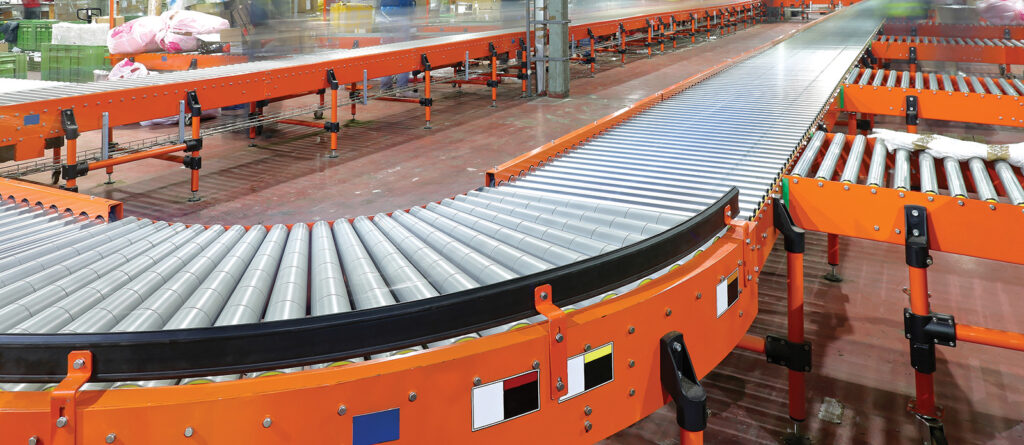ASME B20.1-2021 – Safety Standard for Conveyors and Related Equipment
“Until the ANSI/ASME B20.1 code for conveying devices was established, material conveying devices were held to the same ANSI/ASME A17 code requirements as passenger elevators. This made it nearly impossible for inclined and vertical reciprocating conveyor manufacturers to meet code standards and provide a competitively priced product. PFlow worked with state and local officials for nearly a decade to help author ANSI/ASME B20.1. This code standard was instituted in 1981 and explicitly excludes any conveyors designed or installed for the movement of human beings. Excluding the movement of people allows conveying devices to be installed in places where passenger or freight elevators are prohibited and applies. As the vertical reciprocating conveyor founder and industry leader, PFlow can engineer a solution for your specific vertical material movement needs.” Chuck Cobb, VP-Sales, Marketing & Product Support. PFlow Industries, 414.352.9000, www.pflow.com.
Conveyor belts are used in many industries, including mining, automotive, agricultural, food and beverage, bottling, commercial fishing, manufacturing, warehouse and logistics, and packaging. Their ability to load and unload items and to move materials between multiple levels or floors makes them indispensable in many settings. They save time and can convey objects too heavy for humans to lift and carry. Among conveyor types:
- Mechanical or hydraulic vertical reciprocating conveyors (VRC) that can accommodate heavy loads and can be structured as complex multi-level, multi-directional systems that provide horizontal and vertical movement and offer flexible loading / unloading patterns.
- Belt conveyors that feature a moving belt turned by pulleys.
- Chute conveyors have metal slides down which packages slide to a lower level.
- Gravity roller conveyors that use cylindrical rollers and gravity to slide objects downward.
- Bucket conveyors scoop material with buckets attached to a belt or cable and carry it to a different location before dumping it out.
- Ball transfer conveyors allow objects to be moved in different directions, with the help of rows of metal balls that can turn and rotate.
- Trolley conveyors carry loads beneath them.
About the standard
ASME B20.1-2021 was issued by The American Society of Mechanical Engineers (ASME), an engineering community association whose activities include developing codes and standards.
ASME B20.1-2021 applies to the design, construction, installation, maintenance, inspection and operation of conveyors and conveying systems in relation to hazards. The conveyors may be of the bulk material, package or unit-handling types, where the installation is designed for permanent, temporary or portable operation.
With the exceptions noted below, this standard applies to all conveyor installations. It specifically excludes any conveyor designed, installed or used primarily for the movement of people. It does, however, apply to certain conveying devices that incorporate within their supporting structure workstations or operator’s stations specifically designed for authorized operating personnel.
ASME B20.1-2021 does not apply to conveyors for which specific standards are already in effect, or to equipment such as industrial trucks, tractors, trailers, automatic guided vehicles, tiering machines (except pallet load tierers), cranes, hoists, power shovels, power scoops, bucket drag lines, trenchers, platform elevators designed to carry passengers or an operator, manlifts, moving walks, moving stairways (escalators), highway or railroad vehicles, cableways, tramways, dumbwaiters, material lifts, industrial scissors lifts, pneumatic conveyors, robots or integral machine transfer devices. Some of the foregoing have specific standards.
The provisions of the standard apply to equipment installed one year after the date of issuance (August 31, 2021).
History of the standard
B20.1 was first published in 1947. It is current practice to revise it every three years, to accommodate evolving technology and design developments. The 2021 version revises section 1-3.9, “Gates and Enclosures” to indicate that enclosure height requirements apply “unless guarded by location.”
ASME B20.1-2018, the previous edition of this standard, contained the following changes from the previous edition:
- New provisions for tow conveyors:
- specifying warnings for when carts start automatically
- providing the means to allow the operator to disengage the tow pin from the conveyor pusher without being in front of the cart
- New definitions for mobile hopper railcar/hopper bottom truck unloader conveyor and hold-down wheels
- New guidelines for mobile hopper railcar/hopper bottom truck unloader conveyor
- New guidelines for electrified monorail conveyors used for assembly/inspection/testing processes
- Metric-equivalent values added throughout. An appendix includes specifications for design, installation, commissioning and periodic inspection of vertical reciprocating conveyors.
The next edition of this standard will be issued in 2024.
Conveyor hazards
Many injuries associated with conveyors may be caused by operator error. Loose clothing and jewelry can get trapped in conveyor belts, as can arms, hands and bodies, resulting in broken bones, lacerations, crushing injuries and amputations. Lack of guarding and lockout/tagout procedures; having belts overloaded or moving at excessive speeds; and failing to properly maintain a conveyor belt are also factors.
In addition to evaluating the space, operational needs and weight and size of the objects that will be moved by a conveyor, it is important that safety be factored into the decision-making process. Dealing with a manufacturer who complies with ASME B20.1; who has a rigorous testing program and whose research and development professionals keep safety at the forefront of their activities will help ensure safety for employees who work near and with conveyors. WMHS
- To purchase this standard, visit: https://tinyurl.com/2p8v7khy




